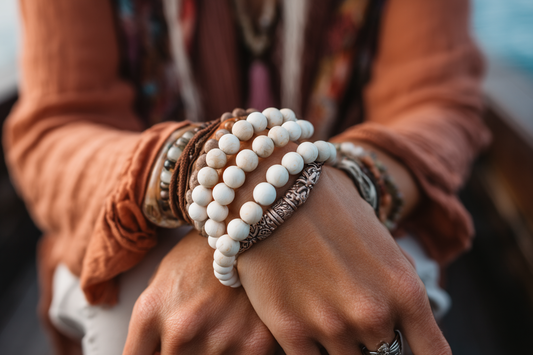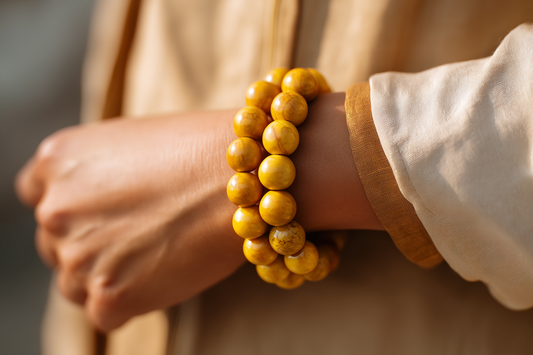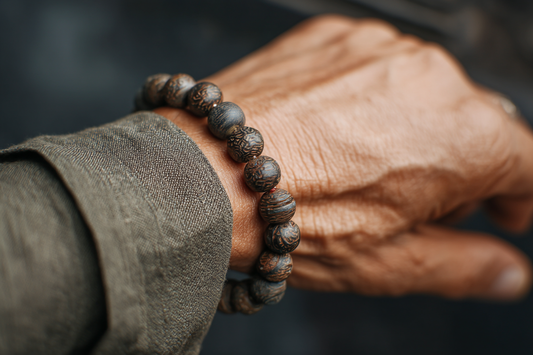側柏木以其濃鬱的香氣、靈性意義和獨特的紋理而聞名,幾個世紀以來一直受到傳統工藝和靈修的珍惜。側柏木常被稱為“生命之樹”,因其守護和淨化的功效而備受推崇,是製作手鍊、念珠和冥想配件的熱門之選。
如果您正在考慮購買側柏木手鍊,本指南將幫助您了解其優點、真實性、工藝和保養,確保您選擇高品質且有意義的作品。
1. 了解崖柏木的美麗和益處
美學訴求
崖柏木擁有獨特的美感,常呈現溫暖的金色至紅棕色調,並帶有複雜的紋理圖案。有些崖柏木珠可能帶有天然的節疤和漩渦紋,更顯其獨特性。拋光錶面帶來順滑舒適的手感,適合日常配戴。
象徵意義和文化意義
崖柏木因其保護和清潔特性而受到許多文化的推崇:
- 在中國和西藏的傳統中,人們相信側柏木可以抵抗負能量。
- 在歐洲民間傳說中,它被稱為“生命之樹”,與長壽和精神啟蒙有關。
- 有些文化使用側柏木念珠(malas)進行冥想和念誦,認為它們有助於集中註意力和獲得內心的平靜。
天然香氣與治療功效
崖柏木最顯著的特徵之一是其獨特的木質香味。幾個世紀以來,這種宜人的香味一直被用於芳香療法,以促進:
- 頭腦清晰,注意力集中
- 平靜和緩解壓力
- 精神基礎與冥想
人們也認為崖柏木具有天然的抗菌特性,使其成為整體健康和能量平衡的絕佳材料。
2. 如何辨識真正的崖柏木
由於其受歡迎程度,真正的崖柏木有時會被仿製。以下是如何區分真材實料的崖柏木與假貨或劣質替代品:
顏色和紋理
- 正宗的崖柏木顏色從淺金棕色到濃鬱的紅色不等,具有自然的紋理。
- 質地細膩,略帶油性,有助於保持其長久壽命。
- 一些高品質的側柏木材可能有小結或漩渦,增加了其獨特性。
香味測試
- 真正的崖柏木會散發出強烈、自然、略帶甜味的雪松香味,這種香味不會隨著時間的流逝而消失。
- 如果手鍊沒有香味或香味很快消失,則可能是合成的或劣質的木質替代品。
重量和密度
- 側柏木質地輕盈,長時間配戴也十分舒適。
- 如果手鐲感覺異常沉重,則可能不是由真正的側柏木製成。
刮痕和水測試
- 輕輕刮擦一顆側柏珠,就會釋放出淡淡的芳香油。
- 將珠子滴入水中可能會增強其天然香味,但正宗的側柏不會吸水或褪色。
3. 選擇適合您的崖柏木手鍊
一旦您確認了真實性,請在選擇符合您的風格和精神需求的側柏木手鍊時考慮這些因素。
珠子的尺寸和形狀
崖柏木手鍊有各種珠子尺寸,通常從6 毫米到 16 毫米不等:
- 6-8 毫米珠子:小巧而優雅,非常適合與其他手鍊搭配。
- 10-12 毫米珠子:尺寸均衡,兼具時尚感與舒適度。
- 14-16 毫米珠子:更大、更突出,通常用於冥想或表達情緒。
珠子的形狀也各有不同:
- 圓珠:最常見且配戴舒適。
- 桶形珠:獨特且略微細長,外觀獨特。
- 雕刻珠子:有些手鍊上刻有像徵性雕刻、神聖圖案或神像,以增加精神意義。
手鍊穿線方法
- 鬆緊繩:靈活且易於穿戴的選擇。
- 結線:傳統且耐用,常用於冥想念珠。
- 可調式滑動結:可實現客製化的貼合度和使用壽命。
附加功能
一些側柏木手鍊與其他天然材料結合,以增強其能量和意義:
- 側柏 + 黑曜石:保護與接地。
- 側柏 + 紫水晶:精神智慧與寧靜。
- 側柏 + 虎眼石:自信與韌性。
- 側柏 + 銀色或金色裝飾:增添優雅奢華的感覺。
4. 搭配你的側柏木手鍊,展現個人風格
側柏木手鍊用途廣泛,可適合不同場合配戴。
休閒裝
中小型珠子的側柏木手鍊可輕鬆與日常服裝搭配,增添自然和樸實的魅力。
正式服裝
對於專業場合,可選擇帶有精緻金屬裝飾的拋光側柏木手鍊,以保持時尚精緻的外觀。
心靈和冥想練習
對於那些使用側柏木手鍊進行冥想或精神目的的人來說,可以考慮帶有 21 或 27 顆珠子的打結念珠手鍊,通常用於吟誦咒語、呼吸或接地練習。
5.適當的保養與維護
為了保持您的崖柏木手鍊的美麗和芬芳,請遵循以下保養提示:
打掃
- 用軟布輕輕擦拭手環,去除灰塵和汗水。
- 避免用水清洗,因為過多的水分會降低木材的天然氣味。
- 如果香味隨著時間的推移而消失,請用手指輕輕摩擦珠子以重新激活天然油脂。
貯存
- 將其存放在軟袋或木盒中,以防止珠子受損。
- 避免陽光直射和極端潮濕,以防止乾燥或開裂。
避免損害
- 請勿將手鐲暴露在香水、化學物質或乳液中,因為它們可能會影響自然的氣味和光澤。
- 避免在淋浴或游泳時佩戴,以保持其完整性。
結論:找到完美的側柏木手鍊
選擇側柏木手鍊不僅僅是一個時尚的選擇,更是與自然智慧和守護能量的連結。無論您是為了精神支柱、放鬆身心,還是僅僅作為一件精美的配飾,一條高品質的側柏木手鍊都能為您的收藏增添一份意義非凡、經久不衰的魅力。






